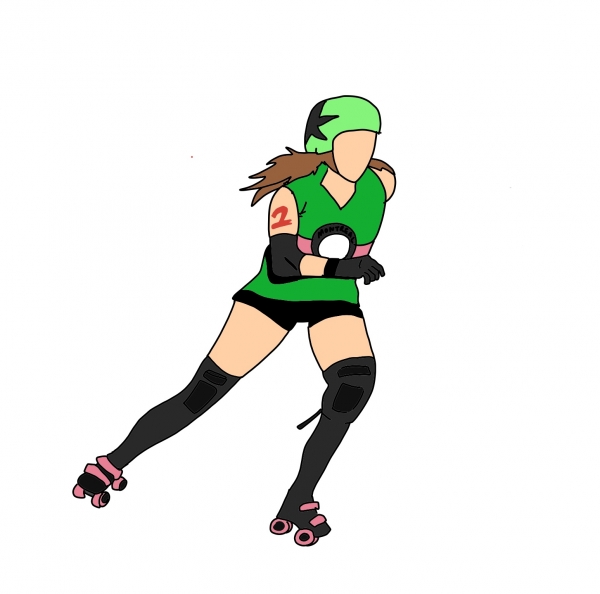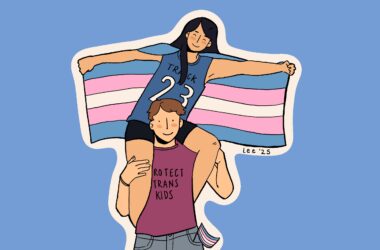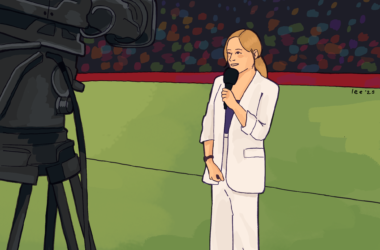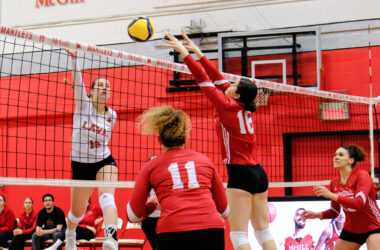Georgia W. Tush founded Montréal Roller Derby (MTLRD), the first flat-track roller derby league in Canada, in 2006. Today, the league consists of three home teams (Les Contrabanditas, Les Filles du Roi, and La Racaille), two “All Star” teams that compete internationally (Sexpos of Montréal and the New Skids On The Block), and the Smash Squad, where rookie skaters practice their skills before being drafted to a team. MTLRD is a non-profit organization in which all players, referees, announcers, and organizers are volunteers. In 2009, MTLRD became a part of the Women’s Flat Track Derby Association (WFTDA), the international governing body for roller derby, comprised of 405 Full Member leagues and 41 Apprentice leagues. MTLRD currently sits eighth in the WFTDA team rankings.
Roller derby is a strategic, full-contact sport, comparable to a cross between rugby and chess. Matches are held on a flat, slightly-lopsided oval track and divided into several rounds called “jams.” Each of the two competing teams puts five players on the track at a time. These players are divided into three main positions: One jammer, one pivot, and three blockers. Over the course of each jam—which can last up to two minutes—jammers skate around the track and attempt to pass players on the opposing team, who move close together in a “pack.” Jammers earn points for each player they pass. Meanwhile, members of the pack—blockers and pivots—can impede opposing skaters through regulated contact such as hip checks. As an added twist, pivots can become jammers by “passing the panty:” If a jammer removes their starred helmet cover (also called a “panty”) and successfully passes it to the pivot, they switch roles for the rest of the jam.
First-time observers may have difficulty grasping the intricacies of the sport, but roller derby is open to anyone brave enough to try it. Brigitte Charest, known as “Eye Roll” on the track, is co-captain of MTLRD’s Smash Squad and a relative newcomer to the sport. In an email to The McGill Tribune, she outlined the process of joining MTLRD.
“First you need to complete a bootcamp, which was held last summer from August to November 2017, and pass what we call the ‘minimal skills test,’” Charest wrote. “This bootcamp is to [ensure] that you can learn the basics of quad skating and Roller Derby action to be safe for you and your teammates. Once [I passed the test], I entered the league in December 2017 for the 2018 Season.”
After attending a roller derby match for the first time last summer, Charest fell in love with the sport.
“I saw my first derby game last summer and LOVED it!” Charest wrote. “I liked the fact that it was on quad skates (I don’t like running), that it is a team sport, athletic, rough, physical and that I saw a bunch of really strong and smart women coming all together on the track. I went to the last [two] games of the season and I knew I’d wanna try.”
For Charest, getting involved in MTLRD has been deeply rewarding. She explained that the tight-knit derby community in Montreal has played an important role in her derby experience.
“It is truly empowering, especially as a young woman,” Charest wrote. “The league is managed by the skaters, for the skaters! Being a part of the league is truly being part of something much bigger than ourselves. We can lean on each other, and it feels great to be there to support other people too. I like having responsibilities, helping, and mostly learning new experiences. The roller derby community in Montreal is a large family! We get to know around 200 new amazing humans in a matter of [a] few weeks!”
Although derby is a full-contact sport, Charest emphasized that the MTLRD community is open to individuals from a range of different skill levels and backgrounds.
“If you have an athletic background it will be easier to get started as [roller derby is] rough on your body,” Charest wrote. “But, skaters [come] in [all] ages, shapes, heights, genders, backgrounds and everyone uses their strength in their own way. In this game, all we have is our body and our mind—there is no ball, or puck, or stick. Roller derby fascinates me [because of] how inclusive the community is. From the first practices you feel in a safe environment and welcome by everyone around.”
Charest stressed that even those who are not interested in participating as skaters can still get involved in MTLRD.
“There [are] also great other ways to get involved,” Charest wrote. “The derby community isn’t just about the skaters, it couldn’t be. We could not be playing if it wasn’t [for] our refs, volunteers and [of] course… fans.”
Despite only having skated for a few months, Charest is deeply immersed in Montreal’s roller derby scene. The sport has helped her develop strong relationships with her teammates and other members of the community.
“In Montreal there [are] a lot of people [involved],” Charest wrote. “At first it can be a bit overwhelming or intimidating to meet all these new people. But there is a good [caring] relationship [between] everyone. I am very close to some teammates as we do activities outside of practices, and some people I’m just starting to know them. I would describe my relationships [as] genuine, caring, natural, honest, fun, considerate, [and] kind.”
Charest highly encourages interested individuals to explore roller derby. MTLRD provides a welcoming space for interested individuals who want to dip their toes in the world of organized sports.
“Everyone can give it a shot, really!” Charest wrote. “If you can get your hands on a pair of skates and protective gear, you’re in for a fun adventure.”









